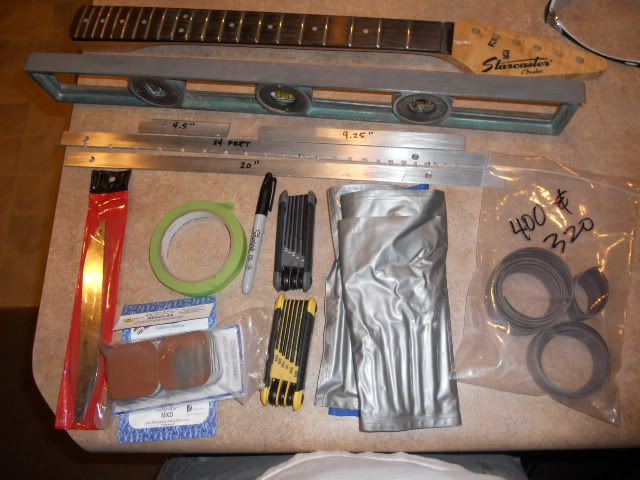I got all the tools, a neck to practice with (thanks again Trem!!), and a free day to take a shot at my first level/crown/polish. Now that I'm done, the overall statement I have would be "Why the fuck didn't I try this sooner?..." The whole process from start to finish took exactly an hour. Now that I've done it, I understand all the instruction and tips I got (thanks to all..) and it really is a straightforward, fairly easy process if you pay attention to what you're doing. I didn't get a before pic and my photography skills may be sub-par but here's a quick synopsis of what I did:
Here's the tools I used.

I straightened the neck, spray adhesived the 320 grit paper to the lapped flat edge of the level (beam for our purposes), sharpie'd the tops, and had the wife-ish hold the neck steady. Started at the center moving the beam about 2" strokes, slowly moving to the treble side, lifted and again starting at the center towards the bass side. Material removal goes pretty quick but not uncontrollable even for a newbie. Kept doing the same thing over and over till it was sanding every fret, took about 20 minutes cause I was going slow and methodical. Then I put 2 pieces of tape on the 10th fret and tape over 1/2 the length or the sandpaper to run smoothly for the fallaway which only took 3 times over the board to hit everything past the 12th fret. Viola, everything was nice and straight and level. Woohoo, must be doing it right!!! And only 1/2 hour into it. Sharpie'd the tops again and started crowning a few frets. Very simple and quick with this file. Ground till there was a very thin line on the top of each fret. Starting to look round.. Again.. seems like I'm on the right track.. Grabbed the Micro-mesh pads. Grabbed the 1500 and held in a curve over my finger and ran it back and forth about 10 times up and down the board. Holy shit.. They're rounded, and pretty perfectly.. There's 10 different grit pads (1500-12000) and I did the same thing with all of them. Took literally about 5 minutes to do it all. After the pads, they look perfectly rounded and like sterling silver. Feel perfectly polished and smooth. Here it is done.

When I do the non-practice necks, I'll take the 12000 pad and polish like jewels. I got some pics but they're crappy. I'll be taking plenty of pics and/or videos when I do the Soloists so anyone who's interested, stay tuned. I'll be doing them in the next few days.
Here's the tools I used.

I straightened the neck, spray adhesived the 320 grit paper to the lapped flat edge of the level (beam for our purposes), sharpie'd the tops, and had the wife-ish hold the neck steady. Started at the center moving the beam about 2" strokes, slowly moving to the treble side, lifted and again starting at the center towards the bass side. Material removal goes pretty quick but not uncontrollable even for a newbie. Kept doing the same thing over and over till it was sanding every fret, took about 20 minutes cause I was going slow and methodical. Then I put 2 pieces of tape on the 10th fret and tape over 1/2 the length or the sandpaper to run smoothly for the fallaway which only took 3 times over the board to hit everything past the 12th fret. Viola, everything was nice and straight and level. Woohoo, must be doing it right!!! And only 1/2 hour into it. Sharpie'd the tops again and started crowning a few frets. Very simple and quick with this file. Ground till there was a very thin line on the top of each fret. Starting to look round.. Again.. seems like I'm on the right track.. Grabbed the Micro-mesh pads. Grabbed the 1500 and held in a curve over my finger and ran it back and forth about 10 times up and down the board. Holy shit.. They're rounded, and pretty perfectly.. There's 10 different grit pads (1500-12000) and I did the same thing with all of them. Took literally about 5 minutes to do it all. After the pads, they look perfectly rounded and like sterling silver. Feel perfectly polished and smooth. Here it is done.

When I do the non-practice necks, I'll take the 12000 pad and polish like jewels. I got some pics but they're crappy. I'll be taking plenty of pics and/or videos when I do the Soloists so anyone who's interested, stay tuned. I'll be doing them in the next few days.


Comment